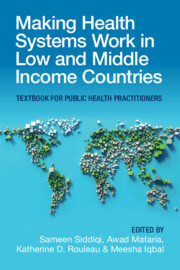 Making Health Systems Work in Low and Middle Income Countries
Making Health Systems Work in Low and Middle Income Countries Role of Health Systems Strengthening
from Section 2 - Transforming Health Systems: Confronting Challenges, Seizing Opportunities
Published online by Cambridge University Press: 08 December 2022
Good health is essential to ensure well-being for individuals, society and nations. However, health is determined by a multitude of factors, and hence achieving the targets set for SDG3 would inevitably require equitable progress in other related SDGs. The health systems in many low-and middle-income countries (L&MICs) have been unable to cope with the needs of the population due to lack of health care workers, financial resources, supplies, monitoring and evaluation. Health systems research can help identify existing gaps and challenges and propose customised solutions based on country needs. A preferred approach to move forward would be an inclusive and multi-sectoral approach with the implementation modalities adapted to the local context. In order to assess the implementation and progress of health-related SDGs targets in L&MICs, a framework comprising of nine domains is proposed which represent political, technical and institutional conditions. A greater political commitment with a focus on reducing inequities and greater accountability would be of paramount importance for any real progress and materialization of SDG targets.
To save this book to your Kindle, first ensure [email protected] is added to your Approved Personal Document E-mail List under your Personal Document Settings on the Manage Your Content and Devices page of your Amazon account. Then enter the ‘name’ part of your Kindle email address below. Find out more about saving to your Kindle.
Note you can select to save to either the @free.kindle.com or @kindle.com variations. ‘@free.kindle.com’ emails are free but can only be saved to your device when it is connected to wi-fi. ‘@kindle.com’ emails can be delivered even when you are not connected to wi-fi, but note that service fees apply.
Find out more about the Kindle Personal Document Service.
To save content items to your account, please confirm that you agree to abide by our usage policies. If this is the first time you use this feature, you will be asked to authorise Cambridge Core to connect with your account. Find out more about saving content to Dropbox.
To save content items to your account, please confirm that you agree to abide by our usage policies. If this is the first time you use this feature, you will be asked to authorise Cambridge Core to connect with your account. Find out more about saving content to Google Drive.